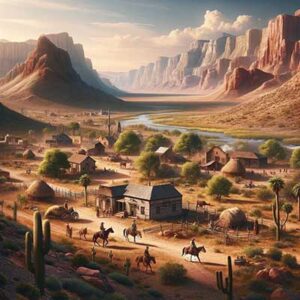Wichita Pre 1899 Did You Know
Wichita's Early Years
Wichita, known as “The Air Capital of the World,” has an exciting history predating its aviation glory. Before 1899, this area witnessed a flood of events and cultures shaping its future. This comprehensive city guide looks into the heart of early Wichita, uncovering facts by painting a bold picture of its foundational years.
Birth of a City: Wichita's Early Settlers
Long before it became a city, Wichita was a gathering place for numerous Native American tribes. The area served as a hunting ground and a meeting point, rich with bison and other game. The name “Wichita” itself originates from the Wichita people, known for their intricate tattoos and trade skills.
In 1863, the first permanent settlement was established by J.R. Mead, who saw potential in this land. This settlement marked the beginning of Wichita’s transformation from a nomadic land into a thriving community. The early settlers were a diverse group, ranging from traders to cattle drivers, each contributing to the city’s development.

1899 and Before Did You Know...
1. Wichita was founded as a trading post on the Chisholm Trail in 1868.
2. The city’s name, Wichita, originates from the Wichita tribe, they inhabited the area first.
3. In 1872, Wichita officially became a city.
4. The first recorded flight in Wichita was by Frenchman Alphonse Pénaud’s toy helicopter in 1871.
5. The historic Delano District, known for its role in the cattle trade, was established in the 1870s.
6. In 1872, Wichita’s first mayor, James R. Mead, was elected.
7. The city’s first newspaper, the Wichita Eagle, began publication in 1872.
8. Wichita’s first railroad, the Santa Fe, arrived in 1872, boosting the city’s growth.
9. The iconic Douglas Avenue, a major street in Wichita, was named after Stephen A. Douglas in 1870.
10. In 1887, Wichita saw the construction of its first skyscraper, the six-story Carey Hotel.
11. The historic Sedgwick County Courthouse was built in Wichita in 1888.
12. In 1890, Wichita became known as the “Peerless Princess of the Plains.”
13. Wichita’s first public park, Riverside Park, was established in 1893.
14. The Lux Building, one of Wichita’s oldest office buildings, was constructed in 1888.
15. Wichita experienced its first major flood in 1877, leading to the construction of flood control systems.
16. By 1890, Wichita had become the largest city in Kansas.
17. The city’s first electric streetcar system began operation in 1887.
18. In 1892, Wichita State University was established as Fairmount College.
19. Wichita’s Mid-Continent Airport, now known as Wichita Dwight D. Eisenhower National Airport, was originally a field used for flying exhibitions in the late 1800s.
20. The historic Orpheum Theatre, a Wichita landmark, was originally built as a first-class vaudeville theater in 1898.
21. In 1873, Wichita established its first fire department, initially staffed by volunteers.
22. The city’s first high school, Wichita High School, opened its doors in 1878.
23. Wichita’s first telephone exchange was established in 1881.
24. In 1897, the first automobile appeared on the streets of Wichita.
25. The iconic Bitting Building, one of Wichita’s first multi-story commercial buildings, was completed in 1887.
26. The first public library in Wichita opened in 1876.
27. Wichita’s first bank, the Wichita National Bank, was founded in 1872.
28. In 1892, Wichita hosted the Kansas State Fair.
29. The city’s first street lights, initially gas-fired, were installed in 1879.
30. The first recorded baseball game in Wichita took place in 1869.
31. Wichita’s first mayor, James R. Mead, was instrumental in the city’s early development and named several of its streets.
32. In 1885, the first horse-drawn streetcar line began operating in Wichita.
33. The historic Scottish Rite Temple, an architectural landmark, was completed in 1898.
34. Wichita’s first hospital, St. Francis, was established by the Sisters of the Sorrowful Mother in 1889.
35. In 1876, the city saw the establishment of its first brewery.
36. The Dockum Drugstore, one of the oldest in Wichita, opened in 1884.
37. In 1891, Wichita experienced a significant economic downturn known as the “Panic of 1891.”
38. Garfield University, which eventually became Friends University, was founded in 1887.
39. The first recorded flight of a hot air balloon in Wichita took place in 1871.
40. In 1890, Wichita was hit by a smallpox outbreak, leading to the city’s first major public health response.
41. Wichita’s first major hotel, the Occidental, was established in 1870.
42. In 1886, Wichita saw the introduction of the first roller skating rink.
43. The city’s first opera house opened in 1887, hosting a variety of theatrical performances.
44. In 1888, Wichita was home to the first electric-powered streetcar in Kansas.
45. The Sedgwick County Historical Museum, originally the city’s City Building, was constructed in 1890.
46. Wichita’s first public swimming pool was opened in 1898.
47. In 1872, the Wichita City Eagle reported the discovery of oil near the city.
48. The first Masonic Temple in Wichita was built in 1887.
49. In 1895, Wichita established its first public kindergarten.
50. The first known bicycle shop in Wichita opened in 1890.
51 Wichita’s first baseball team, the “Red Stockings,” was formed in 1874.
52. In 1896, Wichita experienced a significant blizzard, heavily impacting daily life and commerce.
53. The first recorded music concert in Wichita was held in 1873.
54. The city’s first photographer, O.H. Leonard, started his studio in 1870.
55. In 1880, Wichita’s population reached 4,911, a significant growth from its founding.
56. The first grain elevator in Wichita was built in 1874.
57. Wichita’s first ice cream parlor opened in 1885.
58. In 1898, the city established its first permanent fire station.
59. The first documented wedding in Wichita took place in 1870.
50. In 1875, Wichita hosted its first agricultural fair, showcasing local produce and livestock.
61. Wichita’s first public school, Douglas Avenue School, was established in 1871.
62. In 1878, Wichita constructed its first iron bridge over the Arkansas River.
63. The first bakery in Wichita was opened in 1870, quickly becoming a community staple.
64. In 1893, Wichita established its first bicycle patrol for the local police force.
65. The city’s first mayor, James R. Mead, played a pivotal role in establishing Wichita’s first post office in 1868.
66. Wichita saw the introduction of the city’s first brass band in 1872.
67. In 1874, the first major cattle drive from Texas arrived in Wichita, bolstering its cattle trade.
68. The city’s first recorded tornado occurred in 1877, causing significant damage.
69. Wichita’s first city hall was constructed in 1873.
70. In 1896, electric lighting was introduced to illuminate Wichita’s streets.
71. The first recorded horse race in Wichita took place in 1872 at a local fair.
72. In 1885, the first local telephone company, Wichita Telephone Exchange, was established.
73. Wichita’s first jewelry store opened its doors in 1870.
74. In 1899, the city saw the establishment of its first golf course.
75. The Wichita Street Railway Company was formed in 1887, enhancing local transportation.
76. In 1884, the first local newspaper, the Wichita Daily Beacon, started its publication.
77. The first recorded snowstorm in Wichita occurred in 1876.
78. Wichita’s first gardening club was formed in 1897.
79. In 1892, the city’s first large-scale manufacturing plant, Coleman Plant, was opened.
80. The first recorded murder trial in Wichita took place in 1871, drawing significant public attention.
81. The first zoo in Wichita opened in 1898 with a small collection of native animals.
82. In 1897, Wichita saw its first automobile, a horseless carriage, on the city streets.
83. The city’s first labor union, the Wichita Typographical Union, was established in 1885.
84. In 1883, the first greenhouse in Wichita was built, introducing exotic plants to the area.
The inaugural Wichita Flower Show was organized in 1899, showcasing local horticultural talent.
85. Wichita’s first public monument, a Civil War memorial, was erected in 1892.
The city’s first recorded flood occurred in 1877, leading to significant infrastructural changes.
86. In 1882, Wichita’s first public tennis courts were established.
87 The first major boxing match in Wichita took place in 1895.
88. Wichita’s first photography studio opened in 1870, offering portraits and landscape photography.
89. In 1879, the city organized its first Fourth of July parade, a tradition continuing today.
90. The first documented theatrical performance in Wichita occurred in 1872 in a local saloon.
91. Wichita’s first recorded charity ball was held in 1890, benefiting local health initiatives.
92. In 1886, Wichita introduced its first sanitation department, improving public health standards.
93. The city’s first ice-skating rink opened in 1894, offering winter recreation.
94. Wichita’s first recorded baseball game occurred in 1873, at a makeshift diamond near the city center.
95. The inaugural session of the Sedgwick County Fair was held in Wichita in 1875.
96. Wichita’s first large-scale brewery opened in 1872, contributing to the local economy.
97. In 1898, the city established its first formal system of public transportation, horse-drawn streetcars.
98. The inaugural Wichita Flower Show was organized in 1899, showcasing local horticultural talent.
99. Wichita’s first street fair and carnival was held in 1891, attracting visitors from surrounding areas.
The Cowtown Era: Wichita's Boom
By the 1870s, Wichita had earned the nickname “Cowtown,” becoming a vital center for cattle drives. The Chisholm Trail, a major cattle route, passed through Wichita, bringing prosperity and growth. This era saw the emergence of the city’s first businesses, including trading posts and saloons, catering to cowboys and travelers.
The establishment of the Wichita Stockyards in 1871 further cemented the city’s status as a hub for the cattle trade. These stockyards were among the largest in the Midwest, facilitating the sale and transport of cattle to markets far and wide. The economic boom attracted more settlers, expanding Wichita’s borders and diversity.
Cultivation of Culture and Community
With growth came the cultivation of Wichita’s cultural and community foundations. The late 1800s saw the opening of the city’s first schools and churches, bringing education and spiritual guidance to the residents. These institutions played a crucial role in knitting the community together, fostering a sense of belonging and collective identity.
Entertainment and leisure activities also flourished during this period. The first theater opened in 1870, offering plays and musical performances. Picnics, horse races, and baseball games became popular pastimes, reflecting the community’s burgeoning spirit and camaraderie.
Reflecting on Wichita's
Wichita’s pre-1899 history reveals a city built on diversity, resilience, and community. From its early days as a Native American meeting ground to its rise as a Cowtown, Wichita laid the foundations for its future. These early chapters are crucial for understanding the city’s evolution into a modern metropolis.
As we explore Wichita’s historical landscape, we are reminded of the people and events shapubg its destiny. This journey through time not only enriches our knowledge but also deepens our connection to Wichita, encouraging us to explore further and discover more about this fascinating city.
1stWichitaGuide.com
As we all know, Wichita is an exciting city. To list the city highlights of decades to a small list is really an injustice. Space is limited. However, if you think we left an important date out of our list, please click the contact button below and share your information. Thank you.
